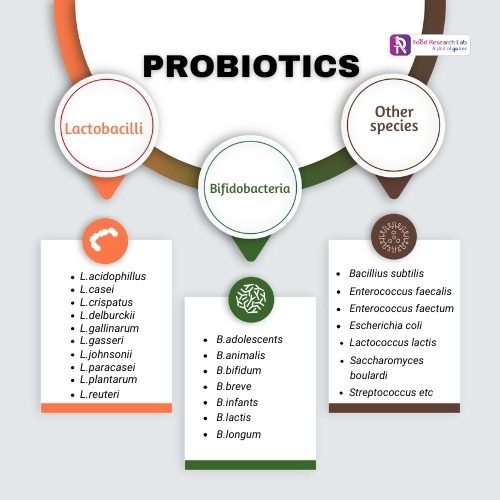Latest Research in Formulation of Probiotic Food and Beverages Products
Introduction
As the twenty-first century has progressed, many experts are now concerned about the state of the gut flora. The symbiotic flora in the human gut is more numerous and complex than that found in other areas of the body. In the colon, there are roughly 3.9 × 1013 adult intestinal flora, which is marginally greater than the total number of human cells. We can categories intestinal flora into three functional groups based on their impact on human health: probiotics, neutral bacteria, and pathogenic bacteria.
The human body and intestinal flora interact to generate functional molecules including amino acids, vitamins, short-chain fatty acids (SCFAs), and other substances required for life, as well as to help the body metabolise toxic waste produced in the intestine and aid in the digestion and absorption of nutrients from food. Maintaining the balance of the intestinal flora is crucial since disruptions can have a negative impact on human health and potentially lead to conditions including obesity, diabetes, irritable bowel syndrome, and colon cancer.
Therefore, external solutions are required to control the ratio of harmful bacteria to probiotics in order to maintain a healthy state of the gut flora.
The International Scientific Association for Probiotics and Prebiotics (ISAPP) defines probiotics as “live microorganisms that, when administered in adequate amounts, confer a health benefit on the host.” In layman’s terms, probiotics are good for our digestive system and are believed to be gut friendly.
Current U.S. regulations for the use of probiotics are complex and largely depend on the intended use. Probiotics generally fall under food ingredients, dietary supplements, or drugs. There is no specific cell count level of the microbe that may guarantee health effects in a food product. However, 106 to 108 colony forming units (CFU)/g is perceived as adequate for reaping probiotic benefits. The most used probiotics contain species of genus Lactobacillus or lactic acid bacteria, and Bifidobacterium. 2

Current Trends in Probiotic Formulation
Novel advancements in the composition of dried probiotics encompass alternative modes of application, like nasal sprays and creams or lotions. Beyond being taken orally as tablets and microcapsules, probiotics are being used in new ways that make better use of their extensive array of health-promoting qualities. It also enables them to adjust to the demands of patients more effectively.
It has been found that probiotic formulations are advantageous for the upper respiratory tract (URT), helping to prevent acute respiratory tract infections. One such example is the formulation of probiotic nasal spray. In order to maintain a stable formulation and the maximum shelf-life stability for L. casei AMBR2, the following combinations were used: 4.5% (w/v) lactose and 1% (w/v) HPMC; 2.5% (w/v) trehalose and 1% (w/v) HPMC (hydroxypropyl methylcellulose); 2.5% (w/v) sucrose and 0.4% (w/v) xanthan gum; 2.5% (w/v) isomalt and 0.4% (w/v) xanthan gum. This was used for preparing probiotic nasal spray using spray drying method. 1
Food Matrix Probiotics
There are many different commercial products that include probiotics, but the majority of them come in the form of nutritional supplements. Still, a wide range of foods, including kimchi, sauerkraut, kefir, and naturally fermented yogurts, contain natural probiotics. 5
Furthermore, non-fermented and—above all—non-dairy food items can serve as a probiotic matrix. Healthy probiotic food can be prepared by utilizing various food matrices, accounting for flavour, nutritional preferences, allergies, and aroma of the end product. Non-dairy probiotic food products include cereals, fruit, vegetable, and meat-based products. They are also excellent providers of protein, dietary fiber, minerals, vitamins, and other bioactive elements that may have additional health advantages. Enhancing the storage stability of probiotics is another benefit of employing food matrices. 6
Let us take a brief look at some favourable food matrixes for probiotic formulations in below sections.
- Dairy Industry: Food manufacturers have been very interested in creating new probiotic products because of how well-liked they are by consumers. Products made from dairy are made naturally to improve health and stave off illness. 4 Dairy products with probiotics are manufactured and consumed globally in a variety of forms, including pasteurized milk, new-born formula, fermented milk, and ice creams. Certain foods, such as cheese, ice cream (e.g. Lactobscillus, L. Plantarum, Lactobacillus acidophilus La5, L. Acidophilus ATCC4356) and fermented milk, are more suited as probiotic carriers because of their ability to buffer pH and fat content, which gives probiotics more protection as they go through the GI system. Bifidobacterium Lactis (BI-04) enriched butiá (Butia odorata) ice cream is one of the many products having probiotic qualities. Probiotic microorganisms were preserved in ice cream for ninety days at -18 °C. Furthermore, butiá was able to preserve its bioactive ingredients while being stored.9
11 Probiotics, prebiotics, conjugated linoleic acids, sterols, stanols, reduced lactose or lactose-free yogurts, and yogurts enriched with functional ingredients have all enjoyed long-term market success. 13 - Beverage Industry: In the probiotic beverage marketplace, fruit juices enhanced with probiotics have been identified as a more distinctive and suitable approach. Because fruit juices provide important nutrients, people of various ages, genders, and geographical locations around the world have come to accept them. Due to the unfavourable conditions that probiotics in beverages endure, their viability in non-dairy foods is shorter than that of dietary supplements. Probiotic juice manufacturing involves a number of considerations for processors, including pH, temperature, anthocyanin, and—above all—a vegetative form of the bacteria. 14
- Bakery Industry: A variety of important nutritional components, including carbohydrates, proteins, lipids, dietary fiber, vitamins, and minerals, are included in varied levels in bakery items (bread, biscuits, doughnuts, cookies, etc.). In an effort to provide probiotics the ability to withstand the high temperatures involved in baking, researchers have been working to develop novel delivery methods for thermo-durable bioactive materials. Examples include: Leveraging microencapsulation and sourdough method for bread making and encapsulation of L. rhamnosus in sodium alginate for pan bread baking. 15 16
- Chocolates: One of the most adaptable functional foods is chocolate, which can be enhanced with probiotics without sacrificing its sensory qualities. It can also be made in numerous ways and have a variety of advantageous benefits combined. For instance, probiotic-enriched chocolate and hazelnut spreads were created, and healthy triacylglycerol were used in place of fat to reduce fat content.7 But there are certain obstacles to overcome, like gastrointestinal conditions, storage issues, and processing issues. Probiotics were encapsulated using emulsion-based freeze-drying formulations that contained cocoa powder and sodium alginate, with an encapsulation effectiveness of up to 95%.8 After 90 days of storage at 25 °C, the researchers were able to retain the probiotics in the product’s viability at over 7.5 log cfu/g thanks to the usage of encapsulated probiotics. They also observed a high degree of viability (8.0 log cfu/g) during in vitro gastrointestinal digestion.
- Banana Powder: Because of its nutritious qualities, low cost, porous structure, and general availability, banana powder makes a great probiotic matrix. After combining probiotic compositions with banana paste, freeze-dried banana powder was created. Lactobacillus acidophilus and Lactobacillus casei microencapsulated with fructooligosaccharides, whey protein isolate, or a 1:1 mixture of the two were added in these formulations. The probiotic formulations were included into banana paste and then chilled for 72 hours at -32 °C. Afterward, they were placed in a freeze dryer for 24 hours at -40 °C. The resultant product was then pulverized and sieved to create a fine powder.
Conclusion
Probiotics are available in a wide range of novel formats. While dairy products and dietary supplements have been the subject of numerous probiotic studies, the development of products suited for use in various applications should not be limited to these areas. Nutraceuticals, medicine, functional foods, non-dairy probiotic foods, cosmetics, and other industries are looking for new uses.
Food Research Lab CDMO is a pioneer in formulating wide range of products – Food & Beverages, Cosmetics, Nutraceuticals by incorporating probiotics. Our scientists and formulation experts are well-versed in novel probiotic innovations with assured quality, providing end-to-end support covering all dimensions to ensure the final product meets the required pH, dispersal, efficacious dosage, shelf life, glycaemic index, desired satiety, mouthfeel, flavour, odour and taste.

Let’s create something Innovative and Delicious together
Food Research Lab strives for excellence in new Food, Beverage and Nutraceutical Product Research and Development by offering cutting edge scientific analysis and expertise.




